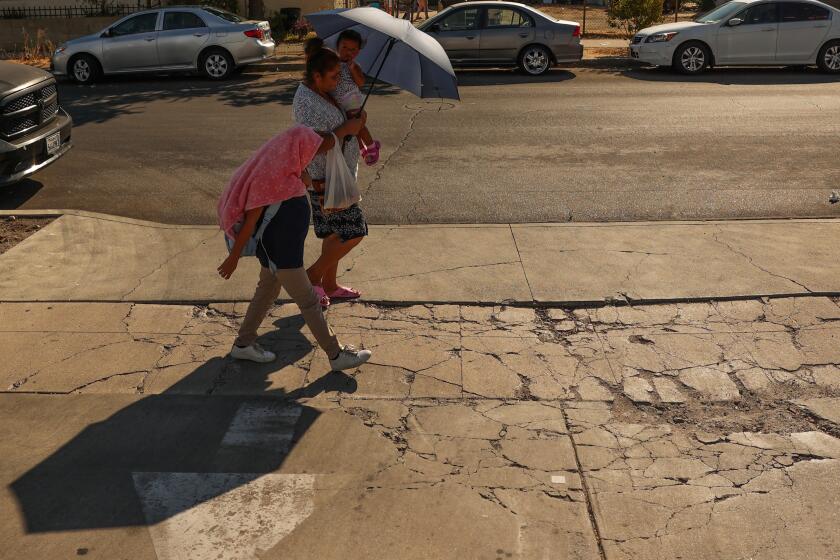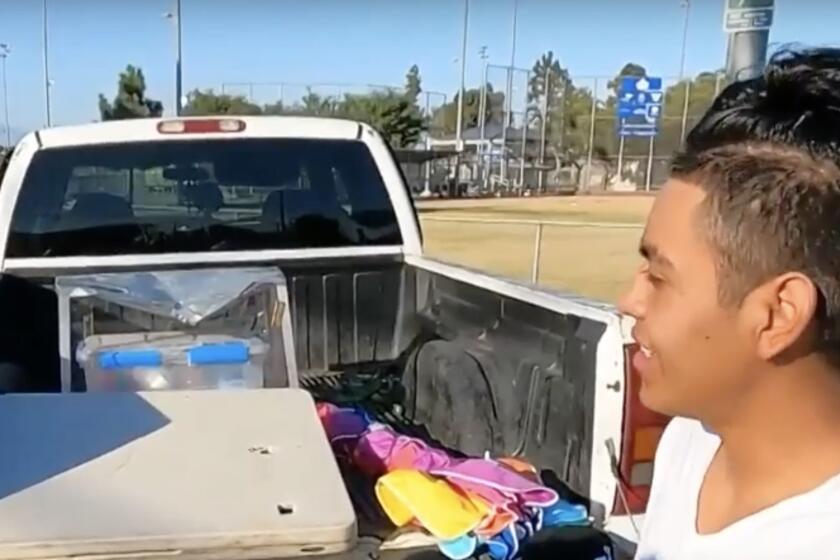Pumped about drilling
This town of 6,700 sits amid the richest oil fields in California, but nobody would mistake it for Dubai.
There are no gleaming towers. Empty storefronts line its downtown streets. One of its two car dealerships recently folded, and a church recently went into foreclosure. To make more money, the city wants to move its eastern border 17 miles and annex an auto raceway under construction beside Interstate 5.
“We have to go out there to collect some revenue,” said Bud Rice, a Taft official who works on economic development. “Without that, we’re basically stuck.”
The decades have not been kind to Taft. Hemmed in by oil fields, the town has little room to grow. Residents shop for deals half an hour away in bustling Bakersfield. Oil workers surge into town from Bakersfield each morning and surge right out again at night.
Thousands of pumps dot the desert around Taft, and many more are coming. With rocketing oil prices, companies have unplugged old wells that were once deemed too costly to operate. Development of new wells has set a pace nearly twice last year’s. Chevron alone has tripled its investment in the area since 2004, budgeting more than $900 million this year to find and pump the oil left behind by previous booms.
“Folks are making big money around the oil patch,” said Les Clark, a spokesman for the Independent Oil Producers Agency, an association of smaller oil businesses in Kern County. Mom-and-pop companies are reviving wells they had shut down because the electricity to pump out the oil cost more than the oil was worth, he said.
In recent years, the oil business has been very good to people like Bruce Holmes. On a century-old oil field in nearby Maricopa, he is moved to grand oratory when contemplating the bad rap oil gets, particularly in communities along the coast.
“Environmentalists live their lives in helium-filled balloons balanced on the backs of the taxpayers,” he says. “The oilman, the bootlegger, the pornographer: People utilize the services we provide, then curse us for providing them.”
Standing beside a well he sank on what was once his grandfather’s homestead, he said he’d had his share of financial ups and downs. At 67, he’s up: He scraped together $250,000 to drill five years ago, when oil went for $25 a barrel or less.
Now it fetches roughly five times that, bringing Holmes $3,000 a day -- enough, he said with an earnest deadpan, “to put beer on the table and keep my Roxy in dog biscuits.”
The heritage of oil runs deep in Kern County, especially in the towns that dot the sage-studded desert west of Bakersfield.
The county yields more than 75% of all the oil produced in California. It pours out more oil than all but three states. America’s biggest gusher erupted here in 1910, and for a year spewed as much as 100,000 barrels a day into an oozing black lake.
Some people still have pictures of graduating high school seniors posed on the arms of big black oil pumps. The region’s twice-a-week newspaper is the Midway Driller (after the vast Midway-Sunset oil field). Taft, the model for New Boston in the epic movie “There Will Be Blood,” has a coffee house called Taft Crude. Every five years, Taft hosts the Oildorado, a blowout complete with a pageant for the Oildorado Queen.
Taft’s high school has its own oil-technology academy. The city’s downtown sidewalks are decorated with sculpture-like pieces of derricks and drills, painted black.
Still, as oil prices hit nosebleed levels, displays of sudden wealth are few.
For some, the memory of harder times is lasting.
“It’s a really frustrating thing,” said Ron Bracken, a lifelong oilman from Maricopa. “For years we were just making ends meet, producing a lot of oil for six bucks a barrel. Now we’re making big money, but it’s just payback for producing for near nothing all those years.”
Outside Taft, plans have been unveiled for a $2-billion clean-energy plant that would trap greenhouse gases below the oil fields. It could create as many as 1,000 temporary construction jobs, officials say.
But in town, it’s business as usual. A Dollar Tree store recently opened, and a Little Caesar’s Pizza is coming in.
“I haven’t seen a lot of change as far as our town goes,” said Mayor Paul Linder. “Folks here are working and doing the things they’ve been doing for years -- they’re pulling oil out of the ground.”
Sales taxes have dipped, he said, because high gas prices have dampened the market for cars. A gallon of regular at a Taft gas station cost $4.67 last week -- about the same as in Los Angeles.
And though Kern County receives nearly 30% of its property taxes from the oil industry, Taft gets little of that directly. Some residents say the town is just starting to recover from the oil bust of the mid-1980s, when oil prices plunged by more than two-thirds. In Taft, once-thriving companies disappeared, along with the people who worked for them.
Now, there are plenty of people passing through. As early as 5 a.m. on weekdays, the road from Bakersfield to Taft is jammed with oil workers who commute some 35 miles to their jobs.
“There’s no decent, affordable places to live in Taft,” said Charlie Beard, owner of an oil field service company and a developer who feels hamstrung by state and federal regulations.
Most of his 160 employees live in Bakersfield. Beard recently moved there too, leaving the town his family has called home since 1943. His wife wanted to be closer to their grandchildren.
Beard said he and several partners have proposed a 3,500-home development that is being stalled by restrictions aimed at saving rare species, such as kangaroo rats and blunt-nosed leopard lizards.
“Bugs and bunnies are more important than people,” he said. “It just makes you want to give up.”
Taft officials say growth is crucial in a town surrounded by oil fields and federal land.
To break free, they have crafted the audacious annexation proposal. If it’s approved, a greatly expanded Taft would receive tax dollars not only from a NASCAR raceway but also from future developments along I-5. Absorbing several poor, unincorporated communities, it would more than triple Taft’s population, to about 20,000.
City officials hope that more people will mean more business.
“For Starbucks, the magic number is 20,000,” Rice said. “Right now, there’s not a lot to spend money on in Taft.”
Meanwhile, the oil continues to flow.
Two weeks ago, Rice set out to count new wells. In a patch of four square miles, he found 60 pumps that weren’t there a month before, adding to the thousands visible from the desert highways that cross the region.
In McKittrick, a tiny town north of Taft, Mike and Annie’s Penny Bar & Cafe dishes up rib-eye steaks to workers ducking in from the fields for lunch.
The cafe is a local landmark; its barroom is lined with glued-on pennies -- maybe a million of them, according to the owners.
At the lunch counter, Claude Hehn, 51, said times are ripe for skilled, veteran oil workers like himself. But even with annual pay of about $130,000, he’s not feeling an excess of confidence.
“A lot of people are making good money now, but they’re not spending it,” he said. Recalling oil’s roller-coaster dips throughout his career, he predicted: “It’ll come back down.”
As for the prospect of expanded offshore drilling, Allen Miller, 35, saw more ups than downs.
A former surfer, he used to drive from his home in Bakersfield to the beaches of Ventura and trusts that today’s technology will minimize the risk of spills.
“I’m as concerned as anyone about the environment,” he said, digging into his French dip sandwich. “But I say: Start punchin’ holes.”
--
More to Read
Sign up for Essential California
The most important California stories and recommendations in your inbox every morning.
You may occasionally receive promotional content from the Los Angeles Times.











